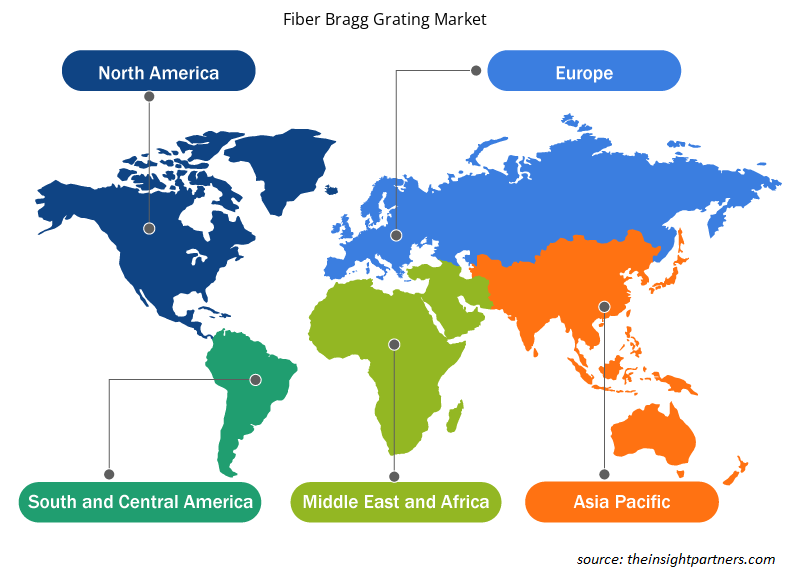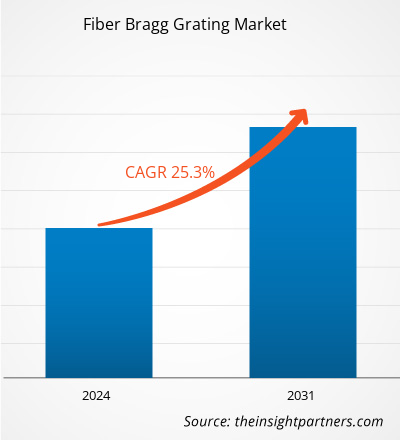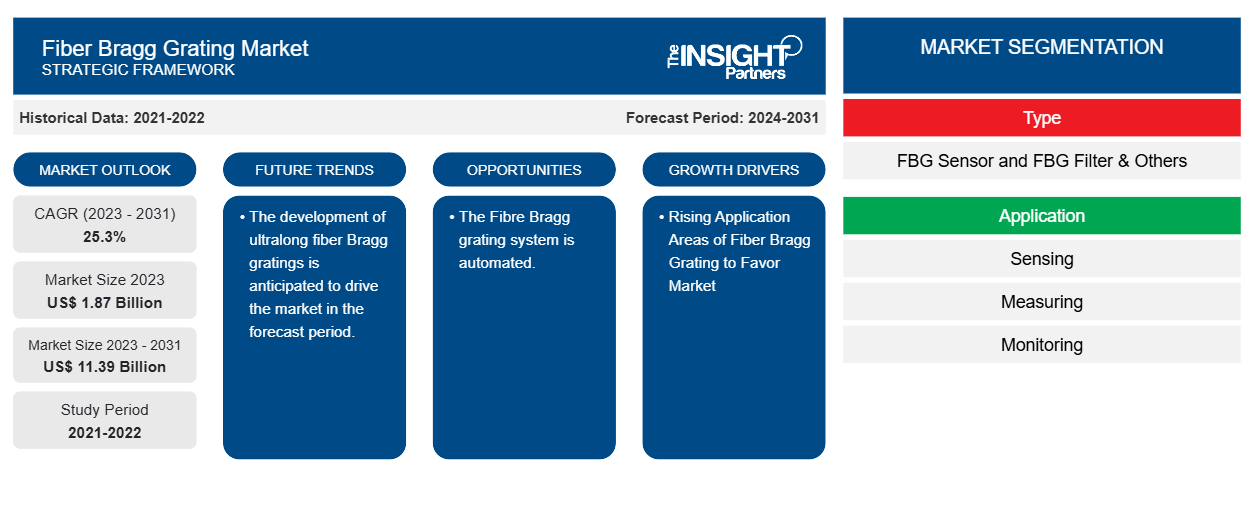파이버 브래그 격자 시장 규모는 2023년 18억 7천만 달러에서 2031년 113억 9천만 달러로 성장할 것으로 예상됩니다. 이 시장은 2023~2031년 동안 25.30%의 CAGR을 기록할 것으로 예상됩니다. 파이버 브래그 격자(FBG)의 적용 분야가 증가하고 FBG의 장점으로 인해 채택이 증가하는 것은 시장의 주요 추세와 원동력으로 남을 가능성이 높습니다.
파이버 브래그 격자 시장 분석
파이버 브래그 격자 시장은 전 세계적으로 상당한 성장을 경험하고 있습니다. 이러한 성장은 파이버 브래그 격자(FBG)의 적용 분야가 증가하고 FBG의 장점으로 인해 채택이 증가하는 데 기인합니다. 또한 자동화된 FBG 시스템의 구현과 초장 파이버 브래그 격자의 개발은 시장에서 여러 기회를 제공할 것으로 예상됩니다.
파이버 브래그 격자 시장 개요
파이버 브래그 격자(FBG)는 일반적으로 길이가 몇 밀리미터인 미세 구조로, 단일 모드 파이버의 코어에 광으로 새겨질 수 있습니다. 이는 UV 레이저 빔으로 파이버를 가로로 조명하고 위상 마스크를 사용하여 코어에 간섭 패턴을 생성하여 수행됩니다. 이는 실리카 매트릭스의 물리적 특성에 영구적인 변화를 유도합니다.
귀하의 요구 사항에 맞게 이 보고서를 사용자 정의하세요
이 보고서의 일부 또는 국가 수준 분석, Excel 데이터 팩을 포함하여 모든 보고서에 대한 사용자 정의를 무료로 받을 수 있으며 신생 기업 및 대학을 위한 훌륭한 혜택과 할인 혜택을 이용할 수 있습니다.
-
이 보고서의 주요 시장 동향을 알아보세요.이 무료 샘플에는 시장 동향부터 추정 및 예측까지 다양한 데이터 분석이 포함됩니다.
파이버 브래그 격자 시장 동인 및 기회
파이버 브래그 격자의 적용 분야가 확대되면서 시장이 활성화될 전망.
파이버 브래그 격자의 적용 분야가 증가하면서 파이버 브래그 격자 시장이 주도권을 잡고 있습니다. 파이버 브래그 격자는 통신, 항공우주, 에너지 및 유틸리티, 운송 등의 산업에서 사용됩니다. FBG는 통신에 중요한 요소입니다. 통신 애플리케이션을 위한 실리카 섬유에 FBG를 UV로 각인하는 것과 비교하면 표준적이고 재현성이 높은 대량 생산 공정으로 발전했습니다. 게다가 주파수인 공간 위상 격자의 역할은 본질적으로 코어에 협대역(투과 또는 반사) 필터 또는 거울을 형성하는 것입니다. 따라서 위의 매개변수를 고려할 때 파이버 브래그 격자의 적용 분야가 증가하면서 시장 성장이 촉진되고 있습니다.
파이버 브래그 격자 시스템은 자동화되어 있습니다.
FBG는 센서로서 수행하는 고유한 특성을 가지고 있습니다. 파이버 브래그 격자(FBG) 센서는 소형, 고감도, 전자기 간섭에 대한 면역성으로 인해 자동화를 포함한 다양한 응용 분야에서 널리 사용됩니다. 이러한 센서는 특정 파장의 빛을 반사하는 동시에 다른 파장을 전송하여 작동하며, 반사된 파장은 온도, 변형 또는 압력의 변화에 따라 이동합니다. FBG는 측정 대상 식별, FBG 센서 선택, 장비와의 통합, 광학적 인트로게이터 연결, 교정 등 자동화의 다양한 단계에서 사용됩니다. 따라서 자동화에서 파이버 브래그 격자의 위의 장점과 특징을 고려할 때, 시장은 향후 몇 년 동안 성장할 것으로 예상됩니다.
파이버 브래그 격자 시장 보고서 세분화 분석
파이버 브래그 격자 시장 분석에 기여한 주요 세그먼트는 유형, 응용 분야 및 산업입니다.
- 유형에 따라 파이버 브래그 격자 시장은 FBG 센서와 FBG 필터 및 기타로 구분됩니다. FBG 센서 세그먼트는 예측 기간 동안 상당한 시장 점유율을 차지할 것으로 예상됩니다.
- 응용 프로그램을 기준으로, 파이버 브래그 격자 시장은 감지, 측정, 모니터링 및 기타로 구분됩니다. 감지 세그먼트는 예측 기간 동안 상당한 시장 점유율을 차지할 것으로 예상됩니다.
- 산업별로 시장은 통신, 항공우주, 에너지 및 유틸리티, 운송 및 기타로 세분화됩니다. 통신은 예측 기간 동안 상당한 시장 점유율을 차지할 것으로 예상됩니다.
지역별 Fiber Bragg Grating 시장 점유율 분석
파이버 브래그 격자 시장 보고서의 지리적 범위는 주로 북미, 아시아 태평양, 유럽, 중동 및 아프리카, 남미 및 중부 아메리카의 5개 지역으로 나뉩니다.
북미는 파이버 브래그 격자 시장을 지배해 왔습니다. 북미 시장은 미국, 캐나다, 멕시코로 세분화되어 있습니다. 이러한 성장은 이 지역에서 파이버 브래그 격자의 적용 분야가 증가하고 FBG의 장점으로 인해 채택이 증가하고 있기 때문입니다. 게다가 자동화된 FBG 시스템의 구현과 초장 파이버 브래그 격자의 개발은 시장에서 여러 기회를 제공할 것으로 예상됩니다. 게다가 미국과 캐나다의 선진 경제권에서 연구 개발에 중점을 두면서 북미 업체는 기술적으로 진보된 솔루션을 시장에 내놓을 수밖에 없습니다. 게다가 미국에는 혁신적인 솔루션 개발에 점점 더 주력하고 있는 파이버 브래그 격자 시장 업체가 많이 있습니다. 이러한 모든 요소가 이 지역의 파이버 브래그 격자 시장 성장에 기여합니다.
Fiber Bragg Grating 시장 지역 통찰력
Insight Partners의 분석가들은 예측 기간 동안 Fiber Bragg Grating Market에 영향을 미치는 지역적 추세와 요인을 철저히 설명했습니다. 이 섹션에서는 북미, 유럽, 아시아 태평양, 중동 및 아프리카, 남미 및 중미의 Fiber Bragg Grating Market 세그먼트와 지리에 대해서도 설명합니다.

- Fiber Bragg Grating 시장에 대한 지역별 특정 데이터 얻기
파이버 브래그 격자 시장 보고서 범위
| 보고서 속성 | 세부 |
|---|---|
| 2023년 시장 규모 | 18억 7천만 달러 |
| 2031년까지 시장 규모 | 113억 9천만 달러 |
| 글로벌 CAGR (2023-2031) | 25.3% |
| 역사적 데이터 | 2021-2022 |
| 예측 기간 | 2024-2031 |
| 다루는 세그먼트 |
유형별로
|
| 포함된 지역 및 국가 |
북아메리카
|
| 시장 선도 기업 및 주요 회사 프로필 |
|
시장 참여자 밀도: 비즈니스 역학에 미치는 영향 이해
파이버 브래그 격자 시장은 소비자 선호도의 변화, 기술 발전, 제품의 이점에 대한 인식 증가와 같은 요인으로 인해 최종 사용자 수요가 증가함에 따라 빠르게 성장하고 있습니다. 수요가 증가함에 따라 기업은 제품을 확장하고, 소비자의 요구를 충족하기 위해 혁신하고, 새로운 트렌드를 활용하여 시장 성장을 더욱 촉진하고 있습니다.
시장 참여자 밀도는 특정 시장이나 산업 내에서 운영되는 회사나 기업의 분포를 말합니다. 주어진 시장 공간에 얼마나 많은 경쟁자(시장 참여자)가 존재하는지 그 규모나 전체 시장 가치에 비해 나타냅니다.
파이버 브래그 격자 시장에서 운영되는 주요 회사는 다음과 같습니다.
- AOS GmbH
- 알네어 랩스 코퍼레이션
- FBGS 테크놀로지스 GmbH
- HBM 파이버센싱 SA
- ITF 테크놀로지 주식회사
- 익스블루 포토닉스
면책 조항 : 위에 나열된 회사는 어떤 특별한 순서에 따라 순위가 매겨지지 않았습니다.

- Fiber Bragg Grating Market의 주요 주요 업체 개요를 알아보세요
Fiber Bragg Grating 시장 뉴스 및 최근 개발
파이버 브래그 격자 시장은 1차 및 2차 연구 이후의 정성적, 정량적 데이터를 수집하여 평가합니다. 여기에는 중요한 기업 간행물, 협회 데이터 및 데이터베이스가 포함됩니다. 파이버 브래그 격자 시장의 몇 가지 개발 사항은 다음과 같습니다.
- 광자 분야의 선두 주자 중 하나인 TeraXion은 새로운 고전력 올 파이버 브래그 격자 노치 필터 제품군을 출시했습니다. WSF 시리즈는 다른 파장은 통과시키면서 파장이나 파장 범위를 선택적으로 감쇠시키거나 차단하는 데 사용되는 올 파이버 대역 차단(노치) 필터입니다. (출처: TeraXion 회사 웹사이트, 2024년 12월)
파이버 브래그 격자 시장 보고서 범위 및 제공물
"Fiber Bragg Grating 시장 규모 및 예측(2021-2031)" 보고서는 아래 영역을 포괄하는 시장에 대한 자세한 분석을 제공합니다.
- 범위에 포함된 모든 주요 시장 세그먼트에 대한 글로벌, 지역 및 국가 수준의 파이버 브래그 격자 시장 규모 및 예측
- 파이버 브래그 격자 시장 동향 및 드라이버, 제약 및 주요 기회와 같은 시장 역학
- 자세한 PEST/포터의 5가지 힘과 SWOT 분석
- 주요 시장 동향, 글로벌 및 지역 프레임워크, 주요 업체, 규정 및 최근 시장 개발 사항을 포괄하는 Fiber Bragg 격자 시장 분석
- 시장 집중도, 히트맵 분석, 유명 업체 및 파이버 브래그 격자 시장의 최근 개발 사항을 다루는 산업 환경 및 경쟁 분석
- 자세한 회사 프로필
- 과거 분석(2년), 기준 연도, CAGR을 포함한 예측(7년)
- PEST 및 SWOT 분석
- 시장 규모 가치/거래량 - 글로벌, 지역, 국가
- 산업 및 경쟁 환경
- Excel 데이터세트
최근 보고서
관련 보고서
사용 후기
구매 이유
- 정보에 기반한 의사 결정
- 시장 역학 이해
- 경쟁 분석
- 고객 인사이트
- 시장 예측
- 위험 완화
- 전략 기획
- 투자 타당성 분석
- 신흥 시장 파악
- 마케팅 전략 강화
- 운영 효율성 향상
- 규제 동향에 발맞춰 대응























 무료 샘플 받기 - 파이버 브래그 격자 시장
무료 샘플 받기 - 파이버 브래그 격자 시장